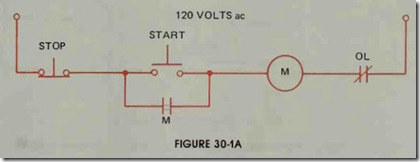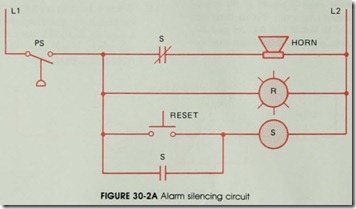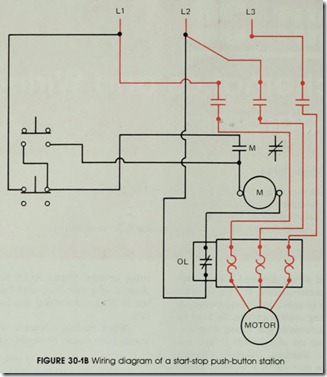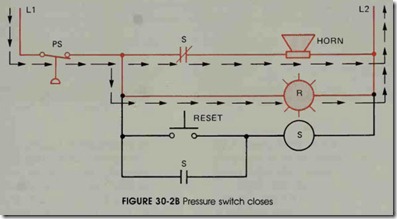Objectives
After studying this unit, the student will be able to:
• Interpret schematic diagrams
• Interpret wiring diagrams
• Connect control circuits using schematic and wiring diagrams
Schematic and wiring diagrams are the writ ten language of control circuits. If a maintenance electrician is going to install control equipment, or troubleshoot existing control circuits, he must be able to interpret schematic and wiring diagrams. Schematic diagrams are also known as line dia grams and ladder diagrams. Schematic diagrams show components in their electrical sequence without regard to physical location. Schematics are used more than any other type of diagram to connect or troubleshoot a control circuit.
Wiring diagrams show a picture of the control components with connecting wires. Wiring diagrams are sometimes used to install new control circuits, but they are seldom used for troubleshooting ex1st1ng circuits . Figure 30-lA shows a schematic diagram of a start-stop, push-button circuit. Fig ure 30-IB shows a wiring diagram of the same cir cuit.
When reading schematic diagrams, the fol
lowing rules should be remembered.
A. Read a schematic as you would a book from top to bottom and from left to right.
B. Contact symbols are shown in their de-en ergized or off position.
When a relay is energized, all the contacts controlled by that relay change position. If a contact is shown normally open on the schematic, it will close when the coil con trolling it is energized.
The following circuits are used to illustrate how to interpret the logic of a control circuit using a sche matic diagram.
Circuit #1
The circuit shown in figure 30-2A is an alarm silencing circuit. The purpose of the circuit is to sound a horn and turn on a red warning light when the pressure of a particular system becomes too great. After the alarm has sounded, the reset button can be used to turn the horn off, but the red warning light must remain on until the pres sure in the system drops to a safe level. Notice that no current can flow in the system because of the open pressure switch, PS.
If the pressure rises high enough to cause pressure switch PS to close, current can flow through the normally closed S contact to the horn. Current can also flow through the red warning light. Current cannot, however, flow through the normally open reset button or the normally open S contact, figure 30-2B.
If the reset button is pushed, a circuit is com pleted through the S relay coil. When relay coil S energizes, the normally closed S contact opens and the normally open S contact closes. When the nor mally closed S contact opens, the circuit to the horn is broken. This causes the horn to turn off. The normally open S contact is used as a holding contact to maintain current to the coil of the relay when the reset button is released, figure 30-2C.
The red warning light will remain turned on until the pressure switch opens again. When the pressure switch opens, the circuit is broken and current flow through the system stops. This causes the red warning light to turn off, and it de-ener gizes the coil of relay S. When relay S de-ener gizes, both of the S contacts return to their origi nal position. The circuit is now back to the same condition it was in in figure 30-2A.
REVIEW QUESTIONS
1. Define a schematic diagram.
2. Define a wiring diagram.
3. Referring to circuit 30-2A, explain the operation of the circuit if pressure
switch PS was connected normally closed instead of normally open.




